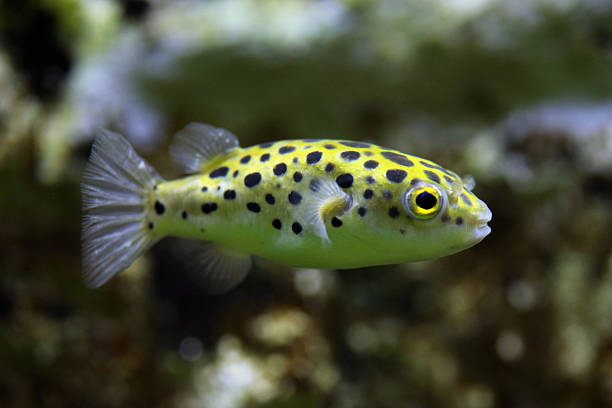Green Spotted Puffer Fish Care, Feeding, and Tank Setup

Green Spotted Puffer Fish, with their distinctive spots and unique personalities, make fascinating additions to any aquarium. However, they have specific needs that differ from typical freshwater fish. This article delves into the essentials of caring for these intriguing creatures, ensuring they thrive in your care.
Overview of Green Spotted Puffer Fish
These puffers boast a pale yellow body with greenish tints and black spots, resembling a leopard. Their small mouth, large eyes, and rounded body give them a distinctive appearance. Despite their small fins used for steering, they primarily rely on their tail for movement. Capable of growing over 6.5 inches, they are known for their intelligence and their ability to recognize their owners. Their aggressive and territorial nature suggests they are best kept alone in an aquarium.
Overview of Green-Spotted Puffer Fish
- Appearance: GSPs have a pale yellow, slightly green body with irregular black spots and a bright white belly. Their rounded body resembles a blimp, tapering at the small tail. They have small, translucent pectoral fins and use their tail for propulsion.
- Behavior and Temperament: They are extremely aggressive and territorial, best kept alone. Recognized for their intelligence, they can show emotions and even learn tricks. They are also known to be escape artists.
- Size: They can grow over 6.5 inches (16 cm).
Tank Setup
- Tank Size: Minimum of 55 gallons for one puffer, with an additional 20 gallons for each additional fish.
- Water Parameters:
- Temperature: 74-82°F (23-28°C).
- pH Levels: 7.0-8.5.
- Water Hardness: 8-12 dGH.
- Alkalinity Levels: 2-4 dKH.
- Specific Gravity: 1.005-1.015 for brackish water.
- Water Flow Rate: Moderate.
- Tank Landscape:
- Substrate: Soft, to prevent injuries from digging.
- Plants: Hardy plants like Java Ferns, Dwarf Sagittaria, and Anubias. Avoid plants that can’t survive in brackish waters.
- Decorations: Driftwood, rocks, caves, and twisted root plants.
- Lighting: Basic aquarium lighting, not too bright.
Feeding and Diet
- Diet: Consists mainly of invertebrates, mollusks, fish, and small worms. Include shellfish, bloodworms, brine shrimp, mysis shrimp, and occasionally algae and vegetable matter.
- Feeding: Live feeder shrimp and snails are essential, as their hard shells help maintain the puffer’s teeth length. Feed younger puffers daily and adults every other day, with portions they can consume within a few minutes.
Maintenance and Care Schedule
- Water Changes: 25% weekly, with regular monitoring of water quality.
- Equipment Inspection: Weekly check of filters, heaters, and other equipment.
- Tank Cleaning: Regular cleaning of substrate and decorations, ensuring ample hiding and swimming spaces.
Common Health Problems
- Diseases: Watch out for ich (white spots) and injuries from nipping.
- Preventive Measures: Regular tank maintenance and monitoring fish behavior.
Breeding
- Difficulty: Breeding GSPs in captivity is challenging and hasn’t been successfully achieved by hobbyists; all specimens are wild-caught.
Conclusion
Green Spotted Puffers are fascinating and unique but require dedicated care and a well-maintained environment. Their aggressive nature means they are best kept alone. Regular maintenance, proper diet, and stable water conditions are crucial for their health and wellbeing.
This guide should offer a detailed and structured approach to caring for Green Spotted Puffers, catering to both novice and experienced fish keepers.